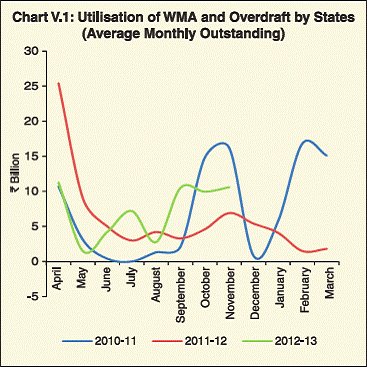 IST,
IST,
V. Outstanding Liabilities, Market Borrowings and Contingent Liabilities of State Governments
The debt-GDP ratio of the states, both at the consolidated as well as the disaggregated level, continued to decline in 2011-12, reflecting the impact of a faster increase in nominal GDP relative to growth in their outstanding debt. The debt-GDP ratio is budgeted to decline further in 2012-13. There has also been an improvement in the debt sustainability of the states. Market borrowings continued to dominate the outstanding liabilities of the states. The weighted average yield of state government securities issued during 2011-12 was higher, due to an elevated level of general interest rates coupled with increased market borrowings and tight liquidity in the market. States have continued to accumulate surplus cash balances, while they reduced their recourse to WMA and overdrafts in 2011-12 over the previous year. The recently-announced scheme for financial restructuring of the state-owned distribution companies (discoms) is likely to increase the liabilities of the state governments in the coming years. 1. Introduction 5.1 After pursuing an expansionary fiscal policy to address the slowdown in the economy in the aftermath of the global crisis, the challenge before state governments in the subsequent years was to revert to the fiscal consolidation path. Most of the state governments, in their budgets for 2011-12 and 2012-13, proposed to carry forward the fiscal consolidation, in line with the recommendation of the FC-XIII. Accordingly, the consolidated debt-GDP ratio of the states continued to decline in 2011-12 and is budgeted to decline further in 2012-13. Against this backdrop, this chapter analyses the outstanding liabilities, market borrowings, contingent liabilities, liquidity position and cash management of the state governments. 2. Outstanding Liabilities 5.2 The consolidated outstanding liabilities of the state governments as a proportion of GDP declined steadily from 2004-05, reflecting the impact of the debt relief mechanism that incentivised states’ adherence to a rule-based fiscal regime. The consolidated debt-GDP ratio of the state governments, which continued to decline in 2009-10 and 2010-11 despite the adoption of an expansionary fiscal policy to combat the economic slowdown, improved further in 2011-12 in line with the state governments’ efforts towards reverting to the fiscal consolidation path (Table V.1). Magnitude 5.3 The consolidated debt-GDP ratio of the state governments declined by 1.2 percentage points in 2011-12 (RE) and is budgeted to decline by a further 0.7 percentage points to 21.9 per cent in 2012-13, which is much lower than the target of 25.5 per cent stipulated by the FC-XIII for the year. Despite a lower debt-GDP ratio, the outstanding liabilities of the state governments increased by 9.6 per cent in 2011-12. The growth in outstanding liabilities in 2011-12 reflected the increase in the GFD at the consolidated level. The growth in outstanding liabilities was more than offset by the strong growth in nominal GDP due to high inflation, resulting in a decline in the debt-GDP ratio during the year.
5.4 The overall debt sustainability of the states has improved over the years as the ratio of interest payments to revenue receipts (IP-RR) declined steadily from 26.0 per cent in 2003-04 to 12.2 per cent in 2011-12 (RE) and is budgeted to decline further to 11.7 per cent in 2012-13. A detailed analysis of the sustainability of state government debt is provided in Chapter VI. Composition of Debt 5.5 The composition of states’ outstanding liabilities reveals increased reliance on market borrowings to finance the GFD, which accounted for around 37 per cent of the outstanding liabilities of the state governments as at end-March 2012. On the other hand, the share of liabilities arising out of the National Small Savings Fund (NSSF) has been steadily declining since end-March 2008. With a reduction in the mandatory allocation of net small savings collections from 80 per cent to 50 per cent from the fiscal year 2012-13, in line with the recommendations of the Committee on Comprehensive Review of National Small Savings Fund, 17 states/UTs have opted for the 50 per cent share (Table V.2). This is expected to lead to a further decline in the share of liabilities to the NSSF in 2012-13. The states’ dependence on loans from the centre has declined sharply from 1999-2000 onwards (Table V.3). The share of highcost debt instruments, viz., state provident funds had risen marginally in end-March 2012. The detailed composition of the outstanding liabilities of state governments from 1990-91 to 2012-13 (BE) is presented in Appendix Tables 19 and 20. The state-wise composition of outstanding liabilities is provided in Statements 26-28. 3. State-wise Debt Position 5.6 The overall debt-GDP ratio of the states has improved since end-March 2005; it has also remained lower than the recommended targets of the FC-XIII for the period 2009-10 to 2012-13. The state-wise debt-GSDP position is presented in Table V.4. Non-Special Category States 5.7 The debt-GSDP ratio of a state represents the final outcome of all the budgetary transactions and is an important indicator of fiscal correction initiatives undertaken during the year. State-wise data reveal that in 2011-12, 15 out of 17 nonspecial category (NSC) states recorded lower debt-GSDP ratios than in 2010-11 (Table V.4). Uttar Pradesh, has the highest debt-GSDP ratio, followed by West Bengal, Punjab and Rajasthan. Chhattisgarh has the lowest debt-GSDP ratio among the Indian states. As per the budget estimates, 15 out of 17 NSC states are expected to record lower debt-GSDP ratios in 2012-13 than in 2011-12. The debt-GSDP ratio is likely to be higher in 2012-13 than a year ago in the case of Chhattisgarh and Madhya Pradesh. 5.8 Consistent with the lower debt-GSDP ratio, an improvement has been noted in the debt sustainability of NSC states. In 2011-12 (RE), all the states were able to contain their interest payments to revenue receipts ratio (IP-RR) within 15 per cent, with the exception of Gujarat, Kerala Punjab and West Bengal. Among the NSC states, the IP-RR ratio was the highest for West Bengal at 27.2 per cent and the lowest for Chhattisgarh at 4.5 per cent in 2011-12 (RE). Special Category States 5.9 Despite higher grants from the centre, special category (SC) states generally exhibit a higher debt-GSDP ratio than the NSC states because the former typically suffer from cost disadvantages that increase their expenditure, while their geographic disabilities limit their fiscal capacity to raise their own resources. In 2011-12 (RE), the debt-GSDP ratio declined in all the SC states compared to 2010-11 except Uttarakhand. The debt-GSDP ratio is likely to remain above 60 per cent in 2012-13 (BE) in Manipur and Mizoram. 4. Market Borrowings Consolidated Position 5.10 Market borrowing has emerged as the most important source of financing the resource gaps of state governments in recent years. The outstanding stock of State Development Loans (SDLs) increased by 21.7 per cent in 2011-12 (RE). The interest profile of outstanding stock of SDLs shows that the share of high-cost market loans has declined substantially in the recent period. The share of outstanding stock of SDLs with interest rates of 10 per cent and above declined sharply from 10.1 per cent at the end of March 2009 to 1.5 per cent at the end of March 2011 (Table V.5). At the end of March 2012, state governments ceased to have any high-cost market loans with interest rates above 10 per cent. On the other hand, the share of market loans with interest rates between 8-10 per cent, has increased sharply from 31.3 per cent at the end of March 2009 to 65.5 per cent at the end of March 2012, indicating that most of the incremental debt has been raised at rates in this range.
Allocation of Government Borrowings during 2011-12 and 2012-13 5.11 Gross market borrowings raised by the state governments were 52.5 per cent higher in 2011-12 (RE) than in 2010-11 (Table V.6). Three states, viz., Assam, Chhattisgarh and Odisha, did not participate in the market borrowing programme in 2011-12 as against four states (Arunachal Pradesh, Chhattisgarh, Odisha and Sikkim) during 2010-11. Fourteen states did not raise their full sanctioned amount in 2011-12 as against four states in the previous year. There were some instances of under-subscription in SDL auctions during the year due to bunching of issuance towards the close of the financial year. 5.12 Reflecting the overall interest rate environment, the cut-off yield in the auction of state government securities ranged between 8.36- 9.49 per cent during 2011-12 compared with 8.05- 8.58 per cent during 2010-11. The weighted average yield of the state government securities issued during 2011-12, at 8.79 per cent, was higher than during the previous year (8.39 per cent), reflecting increased market borrowings by the state governments, a tight liquidity position, the timing of the issuances and general interest rate movements. The range of spread between the yield of benchmark central government securities and the cut-off yield of the SDLs stood at 25-91 basis points during 2011-12 compared with the spread of 31-69 basis points during 2010-11.
5.13 During 2012-13 so far (up to January 4, 2013), state governments have raised an aggregate amount of `1,251 billion on a gross basis with cut-off yields during this period ranging between 8.58-9.31 per cent. Although SDLs are normally issued as fresh securities of 10-year tenor, since August 2012 the SDLs of some state governments have been re-issued. During 2012- 13 so far, `25 billion has been raised through reissuance of existing securities. Maturity Profile of State Government Securities 5.14 Since 2005-06, state government securities have been issued for 10-year maturity only. Deviating from the normal issuance practice, some states were permitted to issue new SDL securities of 4-5 year tenor from July 2012, which attracted lower cut-offs than the normal 10-year SDLs. The maturity profile of outstanding stock of SDLs at the end-March 2012 reveals that the majority of SDLs (around 53 per cent) were in the maturity bucket of 7 years and above (Table V.7). The increase in market borrowings of the state governments since 2008-09 could lead to large repayment obligations from 2017-18 onwards. The recently-announced scheme for financial restructuring of state distribution companies (discoms) requires state governments to take over 50 per cent of their outstanding short-term liabilities as at end-March 2012 through issuance of special securities in favour of participating lenders in a phased manner over a timeframe of 2-5 years and redeem the same from 2017-18 onwards in annual installments over the next 10 years. As these special securities are likely to be significantly larger in size than the power bonds that will be extinguished by the fiscal year 2016-171, the overall repayment pressure could be further aggravated from 2017-18 for states that decide to participate in the scheme for financial restructuring of state discoms with substantial accumulated losses and large outstanding short-term liabilities. 6. Contingent Liabilities 5.15 While the revenue accounts of several state governments continue to record surpluses, despite the moderation witnessed in some states, this needs to be seen in the light of mounting losses in state public sector undertakings (SPSUs), particularly state power distribution companies (discoms), which is a serious cause for concern not only for the SPSUs themselves but also for the banks/financial institutions that have lent to them. The scheme for financial restructuring of state discoms announced by the central government in October 2012, requires, states opting for the scheme to provide guarantees to the bonds to be issued by discoms to participating lenders2. This would add to the contingent liabilities of the state governments. 5.16 At present, the Reserve Bank, on behalf of the state governments, maintains consolidated sinking fund (CSF), which provides a cushion for amortisation of the market borrowings of state governments. The Reserve Bank also maintains guarantee redemption fund (GRF) to service the contingent liability arising from the invocation of guarantees issued in respect of borrowings by state-level undertakings or other bodies. As on March 31, 2012, 19 state governments and the Union Territory of Puducherry had set up CSF and 10 states had subscribed to GRF. The outstanding investments under CSF and GRF amounted to `443 billion and `43 billion, respectively, at the end of November 2012. A working group was set up by the Reserve Bank to examine various investment avenues for the funds available in the CSF so as to make it more viable. The major recommendations of the Group are set out in Box V.1. 7. Liquidity Position and Cash Management 5.17 Many state governments have accumulated sizeable cash surpluses in recent years, reflecting the fiscal consolidation process undertaken since 2004-05. The liquidity pressures during 2011-12 were, thus, confined to a few states. The aggregate ‘normal WMA’ limit for the states, including the Union Territory of Puducherry, was `102.4 billion for 2011-12. The monthly average utilisation of WMA and overdrafts by all states in 2011-12 was lower than that in the previous year (Chart V.1). 8. Investment of Cash Balances 5.18 The surplus cash balances of the state governments are automatically invested in 14-day Intermediate Treasury Bills (ITBs), the discount rate of which is currently fixed at 5 per cent. The monthly average investment in 14-day ITBs decreased to `722 billion in 2011-12 from `789 billion in 2010-11. The monthly average investment in Auction Treasury Bills (ATBs), on the other hand, increased sharply from ` 96 billion in 2010-11 to `277 billion in 2011-12, reflecting the increased preference for this instrument which yields higher returns than ITBs. The monthly average overall investment in ITBs and ATBs by the states increased from `885 billion in 2010-11 to `999 billion in 2011-12 and further to `1,173 billion in 2012-13 (up to November 2012) (Chart V.2). Box V.1 A Working Group (WG), set up to examine various avenues for investment of the Consolidated Sinking Fund (CSF) to make the fund viable, submitted its Report in October 2012. The terms of reference included exploring ways to strengthen the CSF; possible incentives for contribution to the Fund; reviewing and drawing lessons from the fund management/ investment practices being followed for New Pension Scheme; and examining the feasibility and suggesting potential investment avenues besides Government of India securities. The major recommendations of the Report are as f ollows: • There is a need to build up a minimum CSF corpus of 3-5 per cent of state liabilities within the next five years and thereafter to maintain it on a rolling basis. • The roll-over risk needs to be managed with utmost caution, and more so when the cash management of the states is yet to reach a robust stage. The CSF, by providing a backstop facility for redemption of debt, is a critical cushion. • The ability to repay the debt on time during normal/ crisis times is of critical importance in sustaining investor interest in SDLs. The issue of return on CSF needs to be seen in this perspective. • There is strong merit in treating the contribution to CSF as capital expenditure, and the CAG should consider appropriate changes to the accounting rules to align them with the economic rationale of the CSF. • An alternate option of excluding the contribution to the CSF from computation of fiscal deficit while treating the drawdown as a financing item for the fiscal deficit in the year of the drawdown may be considered. This option is conceptually more challenging as it requires changes to the basic concept of fiscal deficit. • The Government of India may explore the possibility of excluding the drawdown of the CSF from the gross borrowing limits under Article 293 (3) of the Constitution in the year of the drawdown. This may be particularly relevant if a state faces auction failure as an unforeseen event or in times of market/fiscal stress. • If a state does not utilise its fiscal deficit limit in any year, the shortfall may be allowed to be utilised as additional fiscal space in the next financial year exclusively for contribution to the CSF. • The Government of India may consider sharing part of the negative carry, if any, between the return on investment in the CSF and the cost of borrowings through SDLs. • There is a continuing need to adhere to the principles of safety, liquidity and return, in that order, for the CSF investment. • A small percentage of the CSF corpus may be considered for investment in Government of India special securities, which may preferably be held to maturity for realising the benefits of high yield. • Investment in SDLs of other states may be taken up from the secondary market in a limited way to start with. • Keeping in view the risk and return profile as also operational/infrastructure requirements, certificate of deposits/bank term deposits may not be considered for CSF investment, at this stage. • Corporate bond/commercial paper/equities/index funds may not be the right avenue for CSF investment. • Overall, investment in treasury bills (TBs), SDLs of other states and special securities of the Government of India should be considered beyond the current practice of investment in government securities. Thereafter, the experience will be reviewed at an appropriate time. • There is a need for caution and calibration before undertaking any shift from the current investment strategy. 9. Debt Consolidation and Relief 5.19 The debt consolidation and relief facility (DCRF) has provided considerable relief to the states in terms of debt write-off and interest relief on outstanding high cost central government loans. All states that have enacted the FRBM Act have benefitted from the DCRF (details are given in Chapter VI). Currently, the scheme has been also extended to West Bengal and Sikkim, which enacted the FRBM Act in 2010-11. The impact of the DCRF and other reform measures is evident from the significant reduction in the average interest rate on outstanding debt since 2004-05 compared to the earlier years (Table V.8).
Conclusion 5.20 The aggregate market borrowings of the state governments recorded an increase in 2011- 12. The debt-GDP ratio of the states, however, continued to decline during the year, reflecting the impact of a faster increase in nominal GDP relative to overall debt. However, the weighted average yield of the state government securities issued during 2011-12 was higher due to increased market borrowings coupled with tight liquidity in the market. States have continued to accumulate surplus cash balances, while they reduced their recourse to WMA and overdrafts in 2011-12 from the previous year. The surplus cash balances of the states were invested in ITBs and ATBs. The DCRF, which had earlier benefitted most of the states in terms of debt and interest relief, is currently being extended to West Bengal and Sikkim, which enacted the FRBM Act only in 2010-11. 1To clear outstanding overdues of State Electricity Boards to the central public sector undertakings (CPSUs), power bonds, aggregating `336 billion, were issued by the state governments with retrospective effect from October 1, 2001 in 20 equal parts to facilitate trading and redemption of the bonds; each part carried a fixed tenor with bullet redemption, the last being on April 1, 2016. |
||||||||||||||||||||||||||||||||||||||||||||||||||||||||||||||||||||||||||||||||||||||||||||||||||||||||||||||||||||||||||||||||||||||||||||||||||||||||||||||||||||||||||||||||||||||||||||||||||||||||||||||||||||||||||||||||||||||||||||||||||||||||||||||||||||||||||||||||||||||||||||||||||||||||||||||||||||||||||||||||||||||||||||||||||||||||||||||||||||||||||||||||||||||||||||||||||||||||||||||||||||||||||||||||||||||||||||||||||||||||||||||||||||||||||||||||||||||||||||||||||||||||||||||||||||||||||||||||||||||||||||||||||||||||||||||||||||||||||||||||||||||||||||||||||||||||||||||||||||||||||||||||||||||||||||||
صفحے پر آخری اپ ڈیٹ:





















